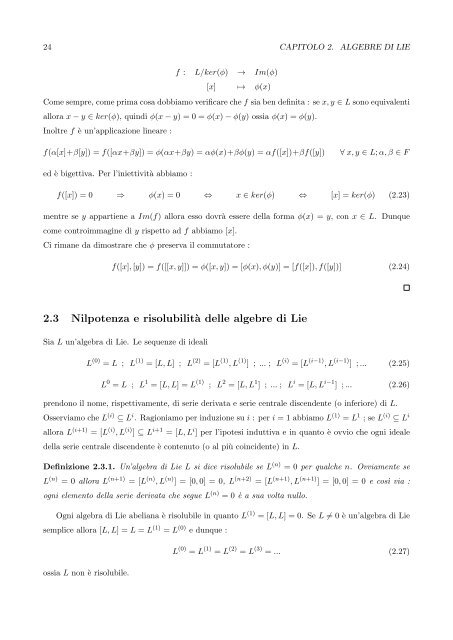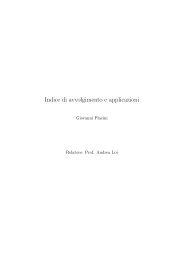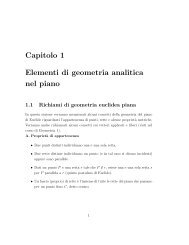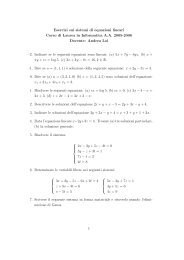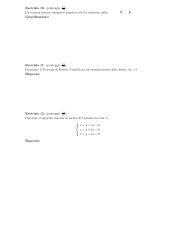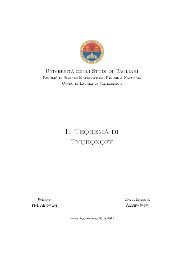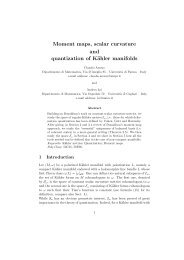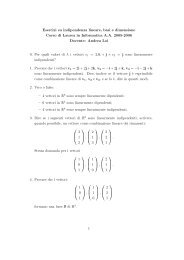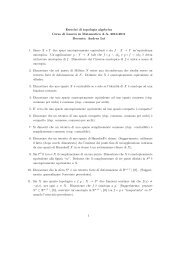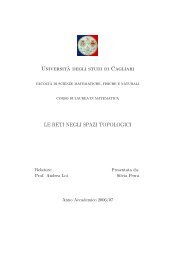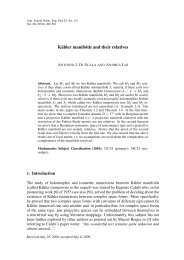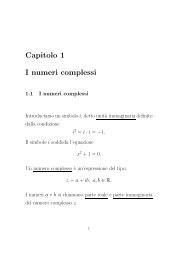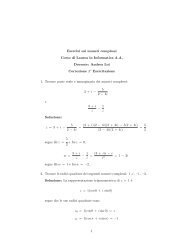Algebre di Lie semisemplici, sistemi di radici e loro classificazione
Algebre di Lie semisemplici, sistemi di radici e loro classificazione
Algebre di Lie semisemplici, sistemi di radici e loro classificazione
Create successful ePaper yourself
Turn your PDF publications into a flip-book with our unique Google optimized e-Paper software.
24 CAPITOLO 2. ALGEBRE DI LIE<br />
f : L/ker(φ) → Im(φ)<br />
[x] ↦→ φ(x)<br />
Come sempre, come prima cosa dobbiamo verificare che f sia ben definita : se x, y ∈ L sono equivalenti<br />
allora x − y ∈ ker(φ), quin<strong>di</strong> φ(x − y) = 0 = φ(x) − φ(y) ossia φ(x) = φ(y).<br />
Inoltre f è un’applicazione lineare :<br />
f(α[x]+β[y]) = f([αx+βy]) = φ(αx+βy) = αφ(x)+βφ(y) = αf([x])+βf([y]) ∀ x, y ∈ L; α, β ∈ F<br />
ed è bigettiva. Per l’iniettività abbiamo :<br />
f([x]) = 0 ⇒ φ(x) = 0 ⇔ x ∈ ker(φ) ⇔ [x] = ker(φ) (2.23)<br />
mentre se y appartiene a Im(f) allora esso dovrà essere della forma φ(x) = y, con x ∈ L. Dunque<br />
come controimmagine <strong>di</strong> y rispetto ad f abbiamo [x].<br />
Ci rimane da <strong>di</strong>mostrare che φ preserva il commutatore :<br />
f([x], [y]) = f([[x, y]]) = φ([x, y]) = [φ(x), φ(y)] = [f([x]), f([y])] (2.24)<br />
2.3 Nilpotenza e risolubilità delle algebre <strong>di</strong> <strong>Lie</strong><br />
Sia L un’algebra <strong>di</strong> <strong>Lie</strong>. Le sequenze <strong>di</strong> ideali<br />
L (0) = L ; L (1) = [L, L] ; L (2) = [L (1) , L (1) ] ; ... ; L (i) = [L (i−1) , L (i−1) ] ; ... (2.25)<br />
L 0 = L ; L 1 = [L, L] = L (1) ; L 2 = [L, L 1 ] ; ... ; L i = [L, L i−1 ] ; ... (2.26)<br />
prendono il nome, rispettivamente, <strong>di</strong> serie derivata e serie centrale <strong>di</strong>scendente (o inferiore) <strong>di</strong> L.<br />
Osserviamo che L (i) ⊆ L i . Ragioniamo per induzione su i : per i = 1 abbiamo L (1) = L 1 ; se L (i) ⊆ L i<br />
allora L (i+1) = [L (i) , L (i) ] ⊆ L i+1 = [L, L i ] per l’ipotesi induttiva e in quanto è ovvio che ogni ideale<br />
della serie centrale <strong>di</strong>scendente è contenuto (o al più coincidente) in L.<br />
Definizione 2.3.1. Un’algebra <strong>di</strong> <strong>Lie</strong> L si <strong>di</strong>ce risolubile se L (n) = 0 per qualche n. Ovviamente se<br />
L (n) = 0 allora L (n+1) = [L (n) , L (n) ] = [0, 0] = 0, L (n+2) = [L (n+1) , L (n+1) ] = [0, 0] = 0 e così via :<br />
ogni elemento della serie derivata che segue L (n) = 0 è a sua volta nullo.<br />
Ogni algebra <strong>di</strong> <strong>Lie</strong> abeliana è risolubile in quanto L (1) = [L, L] = 0. Se L = 0 è un’algebra <strong>di</strong> <strong>Lie</strong><br />
semplice allora [L, L] = L = L (1) = L (0) e dunque :<br />
ossia L non è risolubile.<br />
L (0) = L (1) = L (2) = L (3) = ... (2.27)


